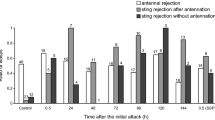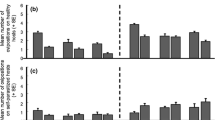Abstract
Foraging behavior for hosts in parasitoids resembles that of predators with respect to finding, evaluating and manipulating of the prey. Host handling time may depend on the life history of the parasitoid and can be affected by oviposition experience. Additionally, handling time can be affected by host aggregation, species, size and state (parasitized or not). We studied handling times in the egg-larval parasitoid wasp Copidosoma koehleri. We allowed naïve female wasps to oviposit into three consecutive unparasitized hosts, and measured time until oviposition, and the duration of ovipositor insertion. We recorded the same data for naïve females ovipositing into already parasitized hosts. We found that both previous experience by females and previous parasitism of hosts reduced handling time. The results suggest that host handling durations reflect the interplay between host state and parasitoid internal state.



Similar content being viewed by others
References
Alcock J (2005) Animal behavior: an evolutionary approach. Sinauer Associates, Sunderland
Amaya KE, Asgari S, Jung R, Hongskula M, Beckage NE (2005) Parasitization of Manduca sexta larvae by the parasitoid wasp Cotesia congregata induces an impaired host immune response. J Insect Physiol 51:505–512
Andrew N, Basio M, Kim Y (2006) Additive effect of teratocyte and calyx fluid from Cotesia plutellae on immunosuppression of Plutella xylostella. Physiol Entomol 31:341–347
Ardeh MJ, de Jong PW, van Lenteren JC (2005) Selection of Bemisia nymphal stages for oviposition or feeding, and host-handling times of arrhenotokous and thelytokous Eretmocerus mundus and arrhenotokous E. eremicus. Biocontrol 50:449–463
Barzman MS, Daane KM (2001) Host-handling behaviours in parasitoids of the black scale: a case for ant-mediated evolution. J Anim Ecol 70:237–247
Bokononganta AH, Neuenschwander P, Vanalphen JJM, Vos M (1995) Host stage selection and sex allocation by Anagyrus Mangicola (Hymenoptera, Encyrtidae), a parasitoid of the mango mealybug, Rastrococcus Invadens (Homoptera, Pseudococcidae). Biol Control 5:479–486
Chow A, Mackauer M (1999) Host handling and specificity of the hyperparasitoid wasp, Dendrocerus carpenteri (Curtis) (Hym., Megaspilidae): importance of host age and species. J App Entomol 123:83–91
Conti E, Jones WA, Bin F, Vinson B (1997) Oviposition behavior of Anaphes iole, an egg parasitoid of Lygus hesperus (Hymenoptera: Mymaridae; Heteroptera: Miridae). Ann Entomol Soc Am 90:91–101
Daane KM, Sime KR, Dahlsten DL, Andrews JW, Zuparko RL (2005) The biology of Psyllaephagus bliteus Riek (Hymenoptera: Encyrtidae), a parasitoid of the red gum lerp psyllid (Hemiptera: Psylloidea). Biol Control 32:228–235
Doutt RL (1947) Polyembryony in Copidosoma koehleri Blanchard. Am Nat 81:435–453
Giron D, Ross KG, Strand MR (2007) Presence of soldier larvae determines the outcome of competition in a polyembryonic wasp. J Evol Biol 20:165–172
Godfray HCJ (1994) Parasitoids: behavioral and evolutionary ecology. Princeton University Press, Princeton
Goubault ME, Fourrier J, Krespi L, Poinsot D, Cortesero AM (2004) Selection strategies of parasitized hosts in a generalist parasitoid depend on patch quality but also on host size. J Insect Behav 17:99–113
Gross P (1993) Insect behavioral and morphological defenses against parasitoids. Ann Rev Entomol 38:251–273
Guerrieri E, Noyes J (2005) Revision of the European species of Copidosoma Ratzeburg (Hymenoptera: Encyrtidae), parasitoids of caterpillars (Lepidoptera). Systematic Entomol 30:97–174
Haspel G, Rosenberg LA, Libersat F (2003) Direct injection of venom by a predatory wasp into cockroach brain. J Neurobiol 56:287–292
Hays DB, Vinson SB (1971) Acceptence of Heliothis virescens (F.) (Lepidoptera, Noctuidae) as the host by the parasite Cardiochiles nigriceps viereck (Hymenoptera, Braconidae). Anim Behav 19:344–352
Heimpel GE, Rosenheim JA, Mangel M (1997) Predation on adult Aphytis parasitoids in the field. Oecologia 110:346–352
Holling CS (1959) Some characteristics of simple types of predation and parasitism. Can Entomol 91:385–398
Horne PA (1990) The influence of introduced parasitoids on the potato moth, Phthorimaea operculella (Lepidoptera: Gelechiidae) in Victoria. Australia Bull Entomol Res 80:159–163
Keasar T, Segoli M, Barak R, Steinberg S, Giron D, Strand MR, Bouskila A, Harari AR (2006a) Costs and consequences of superparasitism in the polyembryonic parasitoid Copidosoma koehleri (Hymenoptera: Encyrtidae). Ecol Entomol 31:277–283
Keasar T, Sheffer N, Glusman G, Libersat F (2006b) Host-handling behavior: An innate component of foraging behavior in the parasitoid wasp Ampulex compressa. Ethology 112:699–706
Kfir R (1981) Fertility of the polyembryonic parasite Copidosoma koehleri, effect of humidities on life length and relative abundance as compared with that of Apanteles subandinus in Potato-Tuber Moth. Ann Appl Biol 99:225–230
Kfir R (2003) Biological control of the Potato Tuber Moth Phthorimaea operculella in Africa. In: Neuenschwander P, Borgemeister C, Langewald J (eds) Biological control in IPM systems in Africa. CABI, Cotonou, pp 77–85
King BH (1994) How do female parasitoid wasps assess host size during sex-ratio manipulation. Anim Behav 48:511–518
Kouame KL, Mackauer M (1991) Influence of aphid size, age and behavior on host choice by the parasitoid wasp Ephedrus californicus—a test of host-size models. Oecologia 88:197–203
Libersat F (2003) Wasp uses venom cocktail to manipulate the behavior of its cockroach prey. J Comp Physiol [A] 189:497–508
Macarthur H, Pianka ER (1966) On optimal use of a patchy environment. Am Nat 100:603–609
Mansfield S, Mills NJ (2004) A comparison of methodologies for the assessment of host preference of the gregarious egg parasitoid Trichogramma platneri. Biol Control 29:332–340
Mills NJ, Kuhlmann U (2004) Oviposition behavior of Trichogramma platneri Nagarkatti and Trichogramma pretiosum Riley (Hymenoptera: Trichogrammatidae) in patches of single and clustered host eggs. Biol Control 30:42–51
Nurindah, Cribb BW, Gordh G (1999) Experience acquisition by Trichogramma australicum Girault (Hymenoptera: Trichogrammatidae). Aust J Entomol 38:115–119
Ode PJ, Strand MR (1995) Progeny and sex allocation decisions of the polyembryonic wasp Copidosoma floridanum. J Anim Ecol 64:213–224
Quicke DLJ (1997) Parasitic wasps. Chapman and Hall, London
Rice WR (1989) Analyzing tables of statistical tests. Evolution 43:223–225
Roitberg BD, Mangel M, Lalonde RG, Roitberg CA, van Alphen JJM, Vet L (1992) Seasonal dynamic shifts in patch exploitation by parasitic wasps. Behav Ecol 3:156–165
Rosenheim JA (1999) The relative contributions of time and eggs to the cost of reproduction. Evolution 53:376–385
Rosenheim JA, Rosen D (1991) Foraging and oviposition decisions in the parasitoid Aphytis lingnanensis—Distinguishing the influences of egg load and experience. J Anim Ecol 60:873–893
Segoli M, Bouskila A, Harari AR, Keasar T (2009) Developmental patterns in the polyembryonic parasitoid wasp Copidosoma koehleri. Arthrop Struct Dev 38:84–90
Shettleworth SJ, Reid PJ, Plowright CMS (1993) The psychology of diet selection. In: Hughes RN (ed) diet selection. Blackwell Scientific Publications, Oxford, pp 56–77
Sih A (1993) Effect of ecological interactions on forager diets: competition, predation risk, parasitism and prey behavior. In: Hughes RN (ed) Diet Selection. Blackwell Scientific Publications, Oxford, pp 182–213
Slansky F (1986) Nutritional ecology of endoparasitic insects and their hosts—an overview. J Insect Physiol 32:255–261
Stephens DW (1993) Learning and behavioral ecology: incomplete information and environmental predictability. In: Papaj DR, Lewis AC (eds) Insect learning: ecological and evolutionary perspectives. Chapman & Hall, New York, pp 195–218
Strand M (2003) Polyembryony. In Carde R, Resch V (eds) Encyclopedia of insects. Academic Press, pp. 928–932
Strand MR, Meola SM, Vinson SB (1986) Correlating pathological symptoms in Heliothis virescens eggs with development of the parasitoid Telenomus heliothidis. J Insect Physiol 32:389–402
Takasu K, Hirose Y (1991) The parasitoid Ooencyrtus nezarae (Hymenoptera, Encyrtidae) prefers hosts parasitized by conspecifics over unparasitized hosts. Oecologia 87:319–323
Vinson SB (1985) The behavior of parasitoids. In: Kerkut GA, Gilbert LI (eds) Comprehensive insect physiology, biochemistry and pharmacology, vol 9. Pergamon, New York, pp 417–469
Vinson SB (1998) The general host selection behavior of parasitoid hymenoptera and a comparison of initial strategies utilized by larvaphagous and oophagous species. Biol Control 11:79–96
Vinson SB, Iwantsch GF (1980) Host regulation by insect parasitoids. Q Rev Biol 55:143–165
von Ende CN (1993) Repeated-measures analysis: growth and other time-dependent measures. In: Scheiner SM, Gurevitch J (eds) Design and analysis of ecological experiments. New York, Chapman and Hall, pp 113–137
Weisser WW, Houston AI, Volkl W (1994) Foraging strategies in solitary parasitoids—the trade-off between female and offspring mortality risks. Evol Ecol 8:587–597
Wiedemann LM, Canto-Silva CR, Romanowski HP, Redaelli LR (2003) Oviposition behaviour of Gryon gallardoi (Hym.; Scelionidae) on eggs of Spartocera dentiventris (Hem.; Coreidae). Braz J of Biol 63:133–139
Acknowledgments
We thank Ori Becher, Sara Baranes, Adi Sadeh, and Daphna Gottlieb for assistance and discussions. This research was supported by THE ISRAEL SCIENCE FOUNDATION (grant No. 184/06)
Author information
Authors and Affiliations
Corresponding author
Rights and permissions
About this article
Cite this article
Segoli, M., Harari, A.R., Bouskila, A. et al. Host Handling Time in a Polyembryonic Wasp is Affected both by Previous Experience and by Host State (Parasitized or Not). J Insect Behav 22, 501–510 (2009). https://doi.org/10.1007/s10905-009-9189-9
Revised:
Accepted:
Published:
Issue Date:
DOI: https://doi.org/10.1007/s10905-009-9189-9




